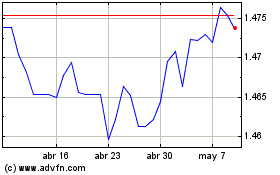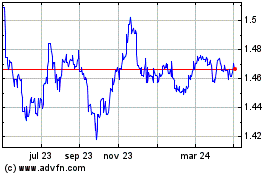German Jobless Decline, Retail Sales Jump Signal Strong Consumption Gains Ahead
01 Marzo 2019 - 2:40AM
RTTF2
Germany's unemployment declined sharply in February, while
retail sales rebounded strongly in January, both surpassing
economists' expectations by wide margins, suggesting that the
growth in the biggest euro area economy is set to be driven by
private consumption as exports suffer due to global factors.
The seasonally adjusted number of unemployed fell by 21,000 in
February, figures from the Federal Labor Agency showed on Friday.
The decline was much bigger a than the fall of 5,000 economists had
predicted.
January's decrease was revised to 4,000 from 2,000.
The non-seasonally adjusted unemployment totaled 2.373 million
in February versus 2.405 million in January.
The seasonally adjusted jobless rate remained unchanged at a
record low of 5 percent in February. The rate has been at this
level since November. The outcome was in line with economists'
expectations.
The Federal Statistical Office reported on Friday that the ILO
jobless rate eased to 3.2 percent in January from 3.3 percent in
December.
"All in all, the German labor market remains an impressive
growth engine for the entire economy, currently defying all
external downside risks and uncertainties," ING economist Carsten
Brzeski said.
"It is a perfect illustration of the current divide of the
German economy between a strong domestic and stuttering external
part."
Earlier on Friday, official data showed that German retail sales
grew at a stronger-than-expected pace in January, entirely
reversing a steep decline in the previous month, to log the biggest
growth in over two years.
Retail sales rose 3.3 percent month-on-month, preliminary data
from the Federal Statistical Office showed. The increase was much
bigger than the 1.90 percent gain economists had predicted.
The latest sales growth was the biggest since October 2016, when
sales rose at the same pace.
The decline for December was revised to 3.1 percent from 4.30
percent.
On a year-on-year basis, retail sales grew 2.6 percent in
January, which also exceeded economists' forecast of 1.20 percent
gain.
The pace of growth was the fastest in three months. In October,
sales grew 6 percent.
The December decline was revised to 1.6 percent from 2.10
percent.
Sales of food, beverages and tobacco grew 2.7 percent
year-on-year and non-food sales rose 2.3 percent.
Within non-food, sales in the other retail group that includes
books, jewelry and so on surged 4.1 percent. Internet and mail
orders sales jumped 6.2 percent.
The market research group GfK has forecast 1.5 percent growth in
German private consumption this year.
Euro vs CAD (FX:EURCAD)
Gráfica de Divisa
De Mar 2024 a Abr 2024

Euro vs CAD (FX:EURCAD)
Gráfica de Divisa
De Abr 2023 a Abr 2024
